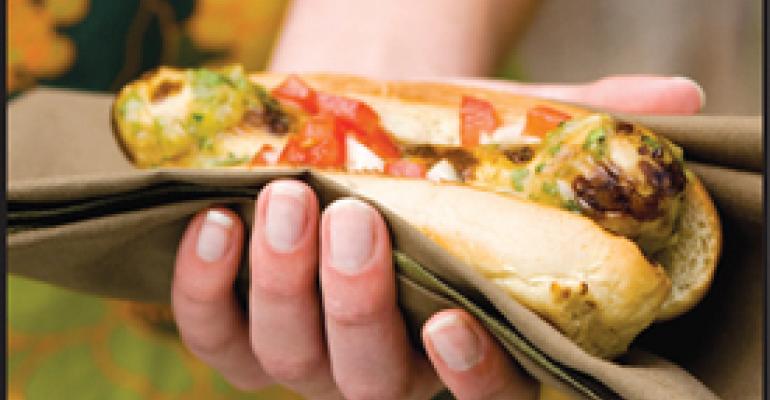Chefs have long had a number of flavor enhancers at their disposal in the kitchen, including salts in a veritable rainbow of colors and descriptions, exotic vinegars, and a variety of infusions. Now, their latest tool for creating innovative tastes comes not from the pantry, but from the refrigerator—beer.
Today’s dishes are getting a subtle boost from all kinds of beer, including bitter pale ales and pilsners, sweet and strong doppelbocks and Scotch ales, complex barleywines and Imperial stouts, fruit beers, spiced ales, chocolate stouts, and even smoked porters. The Belgians call it cuisine à la bière, and the idea of blending food and beer is key to Britain’s gastropubs, but throughout the world cuisine made with beer is simply good, flavorful food.
The key to beer’s versatility lies in both its relatively low alcohol content—most beer styles peak at less than half the strength of most wines, thus negating the risk of fusel flavors appearing in the foods—and its astoundingly wide diversity of flavors. And if that second one sounds a little far-fetched, consider that in beer’s four basic ingredients alone—water, barley malt, hops and yeast—there exists the potential to unleash everything from fruity notes to the taste of chocolate and coffee, from nuttiness to soft caramel, and from smokiness to citrus peel. Add to that the wealth of other ingredients that may be added to the brew’s basic ingredients, such as spices, fruits, vanilla and cocoa, and you have a very broad range of flavors indeed.
No surprise, then, that to a growing number of chefs today this one liquid presents a wealth of culinary possibilities.
Still, beer-savvy chefs say bringing brew to the kitchen is not without potential pitfalls. According to Tim Schafer of Tim Schafer’s at Lake Norman in Sherrills Ford, N.C., and Greg Higgins of Higgins Restaurant in Portland, Ore., the most common mistakes made by budding beer chefs concern the use of hoppy beers such as pale ales, India pale ales and German-style pilsners.
That is because hops, although originally added to beer as a preservative, are today used primarily for their bitterness. Add a hoppy beer too early in the cooking process—or in too great an amount—and that bitterness can easily intensify to the point that it dominates the dish. In extreme cases, says chef Brian Morin of Toronto’s beer-bistro, an ultrahoppy beer can literally dissolve other ingredients, which happened the first time he tried to poach shrimp in a particularly hoppy ale.
Another aspect of cooking with beer that is often ignored, chefs say, is restraint in terms of the quantities used. Like any other ingredient, beer needs to be added judiciously, just as you would use salt or pepper or mustard. In other words, simply because most beers arrive in twelve ounce bottles or cans, it doesn’t mean that amount, or multiples thereof, is going to be right for every dish.
Finally, and most importantly, chefs say, it is vital to forget the idea that all beer is “just beer,” or even that dark beers and light beers, or ales and lagers, are interchangeable within their respective classes. As noted above, the flavors of beer vary widely, and a dark German lager, Belgian brown ale and American amber, for example, will each impart a different character to a dish, despite their similar appearance.
To this end, says Lucy Saunders, author of “Grilling with Beer,” chefs who wish to cook with beer should get used to tasting beer. “I encourage chefs to taste a range of beer styles,” she says, “and then choose beers that are most harmonious for their menus.”
Beerbistro’s Brian Morin shares the buzz on cooking with the variety of available beers Brian Morin knows beer. As principal owner and executive chef of Toronto’s beerbistro, the beer cuisine restaurant and bar in which the author also has a small stake, Chef Morin works with beer every day, creating new and innovative dishes that both reflect and celebrate the multitude of flavors found within the world of beer. But, he says, not all beers are created equal. Like any ingredient, different beer styles best complement different foods. While no generalization is iron-clad, Morin suggests the following guidelines: Stouts & Porters—These beers are great for braising meats like lamb shoulder, since the caramelized flavors of the meat will be echoed by those of the beer. Also, the long cooking time won’t impart a burnt or bitter flavor, as is common with most other beers. Pale Ales & IPAs—Finishing meat dishes with a small amount of hoppy ale adds a refreshing bitterness, although too much beer or too much cooking time can spell disaster. Pilsners—Czech-style pilsners are wonderful for cooking rice or making light batters, since the classic hop for the style, known as Saaz, will impart crisp florals to the dish. Barleywines—Use these to create beautiful complexity in ice creams and other sweet desserts. German-style wheat beers, or Hefeweizens—Their typically spicy, clovey flavor makes them ideal for curing meats, especially hams, and their fruitiness works well in marinades for chicken. Belgian-style wheat beers, or Witbiers—Light and refreshing, with flavors of coriander and citrus, these are wonderful in vinaigrettes and are harmonious with most seafoods. Scottish ales—Their dominant maltiness makes these among the most versatile of beers, good in everything from meat stews to chocolate cakes and desserts.

